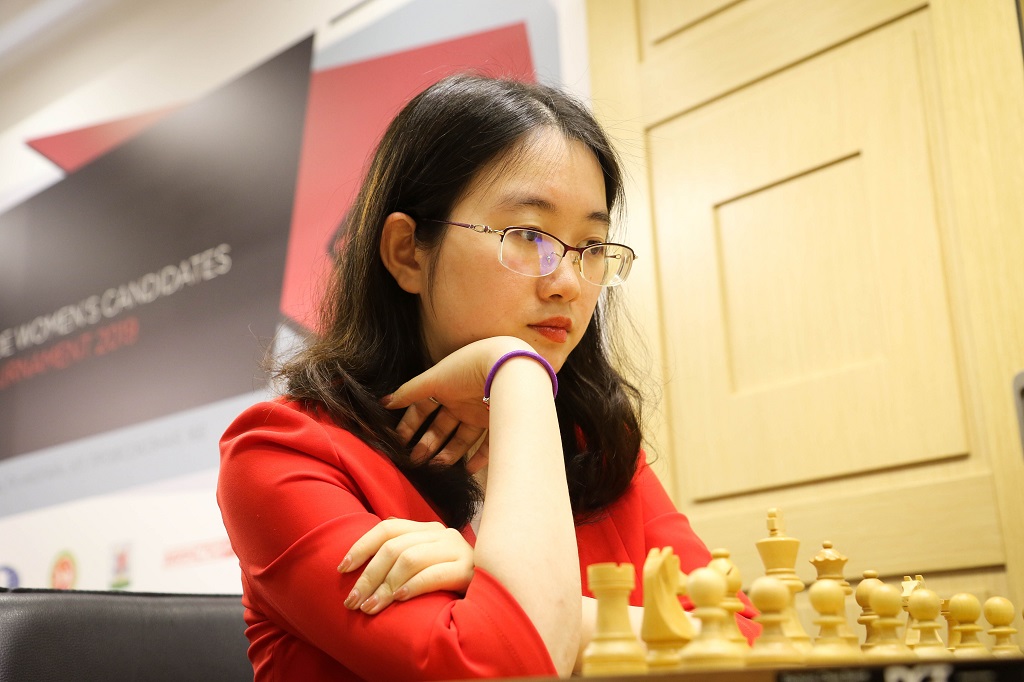.jpeg)

.jpeg)
In round one, two out of four games could have easily finished decisively, while in round two all four games featured fighting chess. Only 20-year-old Aleksandra Goryachkina and 32-year-old Nana Dzagnidze left the playing hall with full points, however, and are the first co-leaders in Kazan.
The results of round two show how evenly disputed this tournament actually is — Valentina Gunina is the lowest rated player, but it would surprise no one if she got first place, while Nana Dzagnidze, the experienced Georgian player, is the second lowest rated player in the field and is now co-leading. After all, only fifty-seven points separate the rating favourite (Mariya Muzychuk) from Gunina. It is anybody's game in Kazan...

Georgia's top female player Nana Dzagnidze | Photo: Eteri Kublashvili
This was clearly the most exciting game of the day. The first one to leave theory was Valentina Gunina, who was looking for a fight despite having the black pieces. Instead of immediately chasing White's bishop out of its comfortable diagonal, she pushed two pawns in rather provocative fashion:
Players like David Navara and Sasikiran had previously opted for 13...♞e6, with their rivals allowing the knight to capture the f4-bishop in the following move. Gunina played 13...d6 instead, and after 14.e3 once again chose not to play 14...♞e6 and went 14...h6. A new path was being explored; Goryachkina continued 14.h4.
Gunina correctly exchanged the queens in the middlegame, despite slightly ruining her pawn structure while doing so. The position was dynamically balanced until Valentina made a strategical mistake on move 35:
In hindsight, it is quite easy to point out the fact that 35...♝xe3 was called for here, simplifying into a rook endgame that would have most likely ended in a draw. However, Gunina played 35...h5, weakening her isolated pawn and allowing her opponent to avoid the exchange of minor pieces with 36.♘g2. Perhaps, she still thought she could fight for a win.

Valentina Gunina, a fighter at heart | Photo: Eteri Kublashvili
And here began a long skirmish, with White looking for the best way to turn her advantage into a win and Black finding the most stubborn resources to defend. At some point, it seemed like Gunina would save the half point, but a blunder on move 69 gave away the game:
The black king's main duty here was to keep an eye on the h-pawn, so to go on and capture with 69...♚xg4 needed a lot of consideration (Gunina played it after a bit over ten seconds) — it is true that both players were in time trouble, but playing it safe here probably was the way to go, even if there was a chance to find a forced line that would have justified the capture. Perhaps Gunina did not foresee White's 72nd move, which came after 70.h7 Rc2+ 71.♔f1 ♜h2:
Goryachkina found the beautiful 72.♘h4! and the game is basically over — the f6-pawn hinders Black's ability to defend the h8-square with the bishop. True to her style, Gunina kept fighting until move 92, but there was no way to save the day.

Young Aleksandra Goryachkina is now a co-leader | Photo: Eteri Kublashvili
Nana Dzagnidze played the Sicilian against the older of the Muzychuk sisters and did not shy away from going into sharp lines, giving up her f-pawn in the early middlegame after theory had been left behind already on move 7. On move 21, the Georgian player provoked a series of exchanges in the centre after thinking for almost twelve minutes:
The game continued 21...d4 22.♗xd4 ♝xd4 23.♕xe4 ♝xf2+ 24.♔h1 and both kings seem rather vulnerable. Black played 24...♛e3 and perhaps Anna regrets not having exchanged the queens here, as after 25.♕c2 (the computers prefer 25.♕b7 or 25.♕xe3) she allowed Black to bring a rook to the attack with 25...♜c5.

Anna Muzychuk vs. Nana Dzagnidze | Photo: Eteri Kublashvili
Black's control of the f-file and her active rook were too much to handle, as Nana demonstrated a couple of moves later:
White's heavy pieces are too far from the action. Black captured both the g and h-pawns in consecutive moves with 28...♜xg2+ 29.♕b7 ♜xh2+ — White captured the rook at this point, but Black's attack is already unstoppable: 30.♔xh2 ♜xf2+ and Anna's best chance was to give up her queen in order to avoid the imminent mate. Dzagnidze's queen and kingside pawns kept putting pressure until forcing her opponent's resignation on move 42.
More videos available at FIDE's YouTube channel
At 35 and 29, Alexandra Kosteniuk and Kateryna Lagno are considered veterans at the pinnacle of women's chess. Their direct encounter in round two saw the Russians playing a Ruy Lopez. Lagno, with the white pieces, got control of the centre but in a critical position missed a chance to make the most of her edge:
At this point, White could have played 23.e5 or 23.exd5 increasing the pressure, but instead opted for 23.♕d3, which prompted Kosteniuk to go 23...♜b8 24.b4 and 24...e5, relieving the pressure. Six moves later, the players agreed to a draw in an equal position with bishops of opposite colours.

Alexandra Kosteniuk with FIDE Press Officer Anastasya Karlovich | Photo: Eteri Kublashvili
Meanwhile, Tan Zhongyi and Mariya Muzychuk played a Semi-Slav Defence which was tensely balanced all throughout the 45 moves that lasted the game. China's third highest-rated woman player pushed her e and f-pawns down the board, but Muzychuk defended accurately and exchanged the queens when given a chance. On move 26, the Ukrainian grandmaster could have changed the path of the game.
Instead of the safe 26...♜g5, Black could have played 26...g5, leading to a position in which White's f-pawn could turn into a critical weakness in the long run. After the text, the simplifications that followed led to the already mentioned peaceful result.

Tan Zhongyi has drawn her first two encounters | Photo: Eteri Kublashvili
Commentary provided by GM Evgeny Miroshnichenko and IM Elisabeth Paehtz